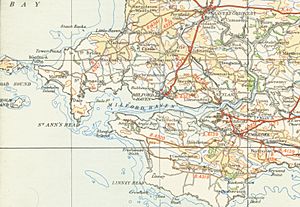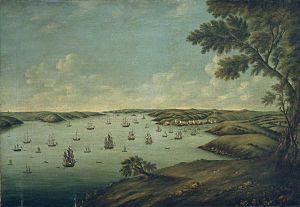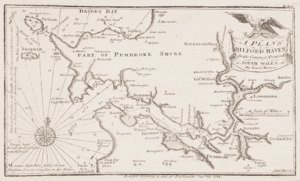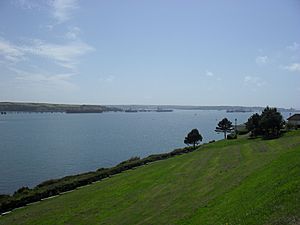Milford Haven Waterway facts for kids
The Milford Haven Waterway (in Welsh, Dyfrffordd Aberdaugleddau) is a huge natural harbour in Pembrokeshire, Wales. It's a "ria," which means it's a river valley that got filled with water when the last Ice Age ended. The Daugleddau river flows into this waterway and then out to the sea. It's one of the deepest natural harbours in the world. This makes it a very busy place for ships. You'll see ferries going to Ireland, huge oil tankers, and smaller pleasure boats.
A famous admiral, Horatio Nelson, visited the Haven and said it was almost as good as the port in Trincomalee, Sri Lanka. He called it "the finest port in Christendom." Many parts of the Waterway's coastline are special protected areas, known as the Milford Haven Waterway SSSI.
Contents
History of Milford Haven Waterway
Early Times and Visitors
From the 790s until 1066, Vikings sometimes used the waterway as a safe place to stop. In 854, a Viking leader named Hubba stayed there with 23 ships. The area of Hubberston is even named after him! Recent discoveries show that people were working with metal here between 750 and 1100.
In 1170, a special religious house called Pill Priory was built near the waterway. It was a daughter house of St Dogmaels Abbey. In 1171, King Henry II chose this area as the meeting point for his journey to Ireland. A huge army of 400 warships, 500 knights, and 4,000 soldiers gathered here. They then sailed to Ireland, which was the first time an English king had landed there. The St Thomas a Becket chapel was built in 1180. It looked over the Haven and was later used as a light for sailors.
The famous writer Shakespeare even mentioned Milford Haven in his play Cymbeline (1611). He wrote about how lucky Wales was to have such a great harbour.
By 1590, two forts were built to protect the entrance to the Haven. George Owen of Henllys wrote in 1603 that Milford Haven was the most famous port in the Christian world. However, the Tudor kings and queens were worried about it. Its location made it easy for enemies from Ireland to attack England through Wales. In 1405, French forces even landed here to help Owain Glyndŵr's rebellion.
In 1603, Martin Pring started his journey to Virginia from the Haven. Later, in the 17th century, Milford Haven became important for the Royalist side during the English Civil War. King Charles I ordered a fort to be built at Pill in 1643. This was to stop Parliamentarian forces. But in 1644, Parliamentarian forces took the fort. Just five years later, in 1649, Oliver Cromwell used Milford Haven as the starting point for his invasion of Ireland. He arrived on August 4 and sailed to Dublin on August 15.
By the late 1700s, two small creeks, Hakin and Castle Pill, were used as ports for loading and unloading coal, corn, and limestone. A ferry service to Ireland also ran from Hakin for a short time. The area around Milford was mostly small villages like Steynton and Hubberston. The only buildings on the future site of Milford town were the old chapel and a farm.
Changing Coastal Landscape
Some parts of the Haven are inside the beautiful Pembrokeshire Coast National Park. The northern side is also a special environmental area. This whole region includes many important natural sites and towns.
The coastline of Milford Haven shows a long history of ships, trade, fishing, and defence. You can still see Iron Age forts on some of the headlands. There are also signs of early Christian and Viking sites. The Norman conquest left its mark with castles in towns like Pembroke and Haverfordwest.
Around 1800, two new towns were built: Milford in 1790 by Sir William Hamilton, and Pembroke Dock in 1802. Both towns were carefully planned. They both saw times of growth and decline in shipbuilding and fishing. These new towns could handle bigger ships. This meant that trade moved away from smaller places further up the river, like Lawrenny and Cosheston. These smaller ports used to serve the coal mines and limestone quarries. They were busy in the 16th, 17th, and 18th centuries.
In the late 1800s, people worried about the French Navy. So, many forts were built along the coast, including in Milford Haven. Most of these forts are not used anymore. The late 1900s brought new industries: oil and power. The Haven's deep waters and location were perfect for huge oil tankers. This industry was biggest in the 1970s.
Milford Haven as a Shipping Port
Milford Haven is the biggest port in Wales and the third largest in the United Kingdom. The Milford Haven Port Authority manages all the shipping here. They also look after Milford Docks, Milford Marina, and Pembroke Port. In 2012, the waterway was named an "Enterprise Zone" because it's so important for energy.
Oil and Gas Industries
Milford Haven became linked to the oil and gas industry in 1960. That's when the first oil terminal and refinery opened. Since then, there have been several oil spills. The port authority has learned a lot from these events. They have a rule to clean up spills first and then figure out who is responsible for paying. There are two large oil refineries nearby. They process about one-fifth of the UK's oil.
In 1996, a ship called the Sea Empress had an oil spill here. It was thought to be one of the worst oil disasters in the UK. But the environment has recovered surprisingly well. This might be because of the very strong tides in the Haven.
Because there's less gas from the North Sea, Milford Haven now has two new terminals for LNG. These terminals could provide 25% of the UK's gas needs! They started being built in 2006. The first LNG ship arrived in March 2009.
Cruise Ship Terminal
The port authority started inviting cruise ships to Pembrokeshire in 2003. More and more passengers have visited since then. In July 2008, the first huge liner to cross the Atlantic, the Maasdam, arrived in Milford Haven.
Milford Haven Town
The town of Milford Haven was started in the 1700s as a place for whaling. Today, its port is the fourth largest in the UK by how much cargo it handles. It's very important for the UK's energy supply, with oil refineries and one of the world's biggest LNG terminals. Milford Haven is the second largest town in Pembrokeshire. It has about 13,100 people. The community of Milford Haven includes the town itself and nearby villages like Hakin, Hubberston, and Steynton.
Power Generation
There are plans to test a wave power plant at West Dale Bay. This is the first step towards using the ocean's waves to create electricity.
Environmental Monitoring
Scientists have measured different chemicals and metals in the Milford Haven Waterway. They check seaweed, mussels, and worms to see how clean the water is. This helps them understand the environmental health of this important waterway.






